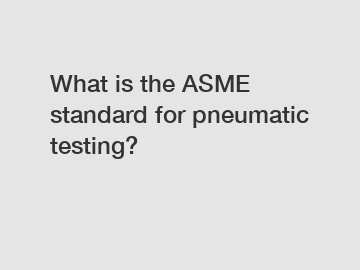What is the ASME standard for pneumatic testing?
What is the ASME Standard for Pneumatic Testing?
When it comes to ensuring the safety and reliability of pressure vessels and piping systems, stringent testing protocols are crucial. In the field of engineering, the American Society of Mechanical Engineers (ASME) plays a pivotal role in setting standards to guarantee the quality and performance of various equipment. One such standard is the ASME requirement for pneumatic testing, which is widely recognized and followed across industries. In this article, we will delve deeper into this important standard and explore its significance.
1. Understanding Pneumatic Testing:

Pneumatic testing is a method used to evaluate the integrity and strength of pressure vessels, valves, and piping systems by subjecting them to pressurized air or gas. This nondestructive testing technique helps identify any leaks, faulty welds, or weaknesses that may compromise the safety and efficiency of the equipment. Pneumatic testing is commonly employed in industries such as oil and gas, chemical processing, and power generation.
2. ASME Standard for Pneumatic Testing:
The ASME Boiler and Pressure Vessel Code (BPVC) provides comprehensive guidelines and standards for the design, fabrication, and inspection of pressure vessels and related components. Part of this code is ASME Section VIII, Division 1, which specifically addresses the requirements for pneumatic testing.
3. Key Requirements:
The ASME standard for pneumatic testing outlines several key requirements that need to be adhered to, including:
a. Equipment Preparation: Prior to testing, the equipment should be thoroughly cleaned to remove any debris or foreign matter. All vent and drain connections must be open, and all gaskets, seals, and packings should be in place.
b. Pressure and Leak Test: The equipment is pressurized using air or gas, typically to a level between 110% and 130% of its maximum allowable working pressure (MAWP). The system is then observed for any visible leaks or pressure drops indicating potential issues.
c. Holding Period: The equipment must be held at the test pressure for a specified duration, usually 10 minutes, to verify its ability to withstand sustained pressure. This period allows inspectors to monitor the system for any changes in pressure or visible leakage.
d. Documentation: It is essential to maintain detailed records of the pneumatic testing process, including the date, pressure levels, duration, and any observations made during the test. This documentation serves as evidence of compliance with the ASME standard.
4. Importance of ASME Standard for Pneumatic Testing:
The ASME standard for pneumatic testing is crucial for ensuring the safety and reliability of pressure vessels and associated systems. Here's why this standard is of utmost importance:
a. Safety Assurance: Pneumatic testing helps identify potential weaknesses or flaws in equipment before it is put into service. By adhering to the ASME standard, companies can be confident that their equipment meets necessary safety requirements and minimizes the risk of accidents or failures.
b. Regulatory Compliance: Many regulatory bodies govern industries that utilize pressure vessels and piping systems. Compliance with the ASME standard ensures that companies meet these regulatory requirements, avoiding legal complications and penalties.
c. Quality Assurance: Adhering to internationally recognized standards like ASME demonstrates a commitment to quality. Customers and stakeholders can have increased confidence in a company's products and services, leading to improved customer satisfaction and a positive reputation in the industry.
d. Interchangeability: The ASME standard ensures that pressure vessels and components adhere to uniform specifications. This allows for compatibility and interchangeability of equipment, facilitating easier repairs and replacements when necessary.
In conclusion, the ASME standard for pneumatic testing plays a vital role in ensuring the safety, reliability, and performance of pressure vessels and piping systems. By following the guidelines outlined in the ASME Boiler and Pressure Vessel Code, companies can demonstrate their commitment to quality and compliance with regulatory requirements. Adhering to this standard not only helps prevent accidents and failures but also enhances customer confidence and industry reputation. When it comes to pneumatic testing, the ASME standard sets the benchmark for excellence.
Are you interested in learning more about Flange Management Process, Pressure Testing Pipe with Nitrogen, Flange Management Service China supplier? Contact us today to secure an expert consultation!


